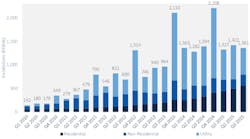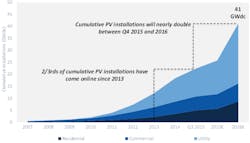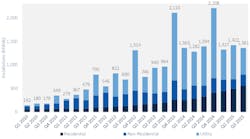Boston, MA, and Washington, DC. A new report shows 2015 shaping up to be the United States solar market’s best year in history with record-breaking fourth quarter projections.
The U.S. installed 1,361 megawatts (MW) of solar photovoltaic (PV) capacity in the third quarter of the year. According to GTM Research and the Solar Energy Industries Association’s (SEIA) U.S. Solar Market Insight Report, Q3 2015, this marks the eighth consecutive quarter in which the U.S. has installed more than a gigawatt (GW) of PV capacity.
“This past quarter marked the calm before the storm,” said GTM Research Senior Solar Analyst Cory Honeyman. “The one-gigawatt mark for quarterly capacity additions will serve as a distant floor as project developers ramp up installations in the next five quarters before the planned step down of the 30% federal Investment Tax Credit (ITC).”
GTM Research expects the fourth quarter of this year to be the largest quarter for solar installations in U.S. history. Led by the utility-scale segment, the United States will install more than three GW. Looking further out, cumulative PV installations will nearly double between now and the end of 2016, bringing the nationwide total to 41 GW.
The utility-scale market continues to lead the U.S. solar market. Utility-scale PV installations made up 42% of the nationwide total, while residential installations accounted for 41%. Additionally, the residential market hit another new quarterly record as it grew 69% year-over year.
Despite some inconsistencies in the non-residential market, the report notes this segment also made progress, increasing 4% year-over-year and 19% over last quarter.
GTM Research forecasts that the U.S. solar PV market as a whole will grow 19 percent over 2014 and will reach 7.4 GW by the end of 2015.
“Year after year, we’re seeing the demand for solar energy in America skyrocket, and the benefits that brings to both our nation’s economy and environment are staggering,” said Rhone Resch, SEIA President and CEO. “As we gear up for what’s expected to be an unprecedented year for our industry, and nation, this report reveals just how important it is to maintain smart, effective, forward-looking public policies, like the ITC.”
Here are key findings from the report:
- The U.S. installed 1,361 MW DC of solar PV in Q3 2015, marking the eighth consecutive quarter in which the U.S. added more than 1 GW DC of PV installations.
- Throughout the first three quarters of 2015, 30% of all new electric generating capacity brought online in the U.S. came from solar.
- As of Q3 2015, more than 50% of all states in the U.S. have more than 50 MW DC of cumulative solar PV installed.
- Totaling 18.7 GW DC, the current utility PV development pipeline is greater than all U.S. PV installations brought on-line through the end of 2014.
- GTM Research forecasts that 7.4 GW DC of new PV installations will come on-line in 2015, up 19% over 2014. Growth will occur in the residential and utility PV segments, while for the second straight year, non-residential solar will dip 5%.
- 2014 was the largest year ever for concentrating solar power, with 767 MW AC brought on-line. The next notable CSP project slated for completion is SolarReserve’s 110-MW AC Crescent Dunes, which entered the commissioning phase in 2014 and is expected to become fully operational by early 2016.
About the Author

Rick Nelson
Contributing Editor
Rick is currently Contributing Technical Editor. He was Executive Editor for EE in 2011-2018. Previously he served on several publications, including EDN and Vision Systems Design, and has received awards for signed editorials from the American Society of Business Publication Editors. He began as a design engineer at General Electric and Litton Industries and earned a BSEE degree from Penn State.


